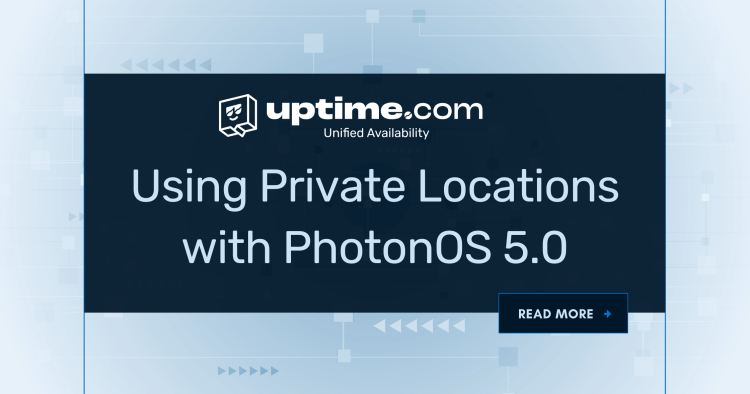
Using Private Locations with PhotonOS 5.0
Uptime.com’s Private Location monitoring tools offer a powerful solution for keeping an eye on internal endpoints. Though these services and their importance aren’t visible to the public, internal teams and customers may still rely heavily on internal services in their day-to-day functions and downtime can disrupt operations just as much as public-facing incidents.
By deploying a Docker container within your network, you can monitor these services while still being alerted to incidents and viewing reports directly within the Uptime.com interface, just as with a public check. This approach ensures that any internal issues are detected and can be addressed before they significantly affect operations, all within the same platform that you use to monitor public checks.
Though our general recommendation for Private Location monitoring is Ubuntu 20.04+, we are also aware of the potential usefulness of other operating systems, such as PhotonOS. This is a lightweight, open-source Linux operating system developed by VMware. Designed to be minimalist and secure, it’s optimized for cloud computing platforms, VMware vSphere deployments, and cloud-native applications. Uptime.com supports PhotonOS 5.0 as “Best Effort Support (Verified)”, which means that our team has deployed, validated, and tested to ensure that our Private Location Monitoring 4.x can run on PhotonOS.
Prerequisites
The PhotonOS 5.0 container has been deployed and tested using an EC2 AWS instance. If your setup and configuration differs from our test environment, support may be minimal.
For the best results, please also ensure you are utilizing the latest version of Docker.
Deploying PhotonOS 5.0 with Docker-in-Docker Setup
To begin, VMware provides an official docker image of Photon OS, which can be found here.
To pull the latest image version from Vmware’s Dockerhub please use the following commands:
docker pull photon
sudo docker run –rm -it -v /var/run/docker.sock:/var/run/docker.sock photon:latest
Using the first command listed will pull the image from Vmware’s Docker Hub. Utilizing the second command (with root privileges) will run the docker container for your PhotonOS instance.
Please note the following flags:
- –rm: Using this flag tells your Docker daemon that, once the container is done running, remove/erase everything related to it and save the disk space that was being allocated to it.
- -it: Short for –interactive & –tty, when running the container with these flags, you will be taken directly in the container with an interactive shell.
- -v: Short for –volume, is used to create storage space inside your container that would be separate from the rest of the container’s filesystem. Using this flag with two arguments as seen above (path_on_host:path_in_container) mounts a specified directory on the host inside of the container. This is used for Docker-in-Docker functionality.
Next to install Docker within your PhotonOS container, please use the following commands:
tdnf install -y docker
systemctl start docker
systemctl enable docker
Finally, to run your Private location within your PhotonOS container, please use the following command from our Github page:
sudo docker run –rm –detach \
–env UPTIME_API_TOKEN=”<YOUR_UPTIME_API_TOKEN>” \
–shm-size=2048m \
–mount type=volume,dst=/usr/local/nagios/var,src=uptime-nagios-var \
–mount type=volume,dst=/home/uptime/var,src=uptime-var \
–mount type=volume,dst=/home/uptime/logs,src=uptime-logs \
–tmpfs /home/uptime/run:uid=1000,gid=1000 \
–hostname localhost \
uptimecom/uptime-private-location:4.0
To ensure your Private Location is working as expected within your PhotonOS container, you may use the following commands:
sudo docker exec -it “container-id” /bin/bash
tail -f /home/uptime/logs/taskqueue.log
Known Issue: Configuration Persistence
Throughout our testing, the Uptime.com team have encountered an issue regarding configuration persistence. Please ensure any necessary configuration changes made inside the PhotonOS container are saved by committing the container to a new Docker image, if required.
Conclusion
PhotonOS 5.0 is a lightweight and secure operating system, and its focus on cloud-native applications makes it a natural fit for Private Location monitoring through Uptime.com’s tools. As an alternative to other Linux operating systems, you may want to consider using it to monitor your internal endpoints to ensure that users and customers experience uninterrupted access to the services they depend on.
Minute-by-minute Uptime checks.
Start your 14-day free trial with no credit card required at Uptime.com.
 Uptime.com Blog
Uptime.com Blog


